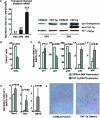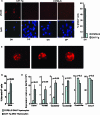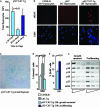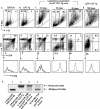Beta-catenin expression results in p53-independent DNA damage and oncogene-induced senescence in prelymphomagenic thymocytes in vivo
- PMID: 18160717
- PMCID: PMC2258783
- DOI: 10.1128/MCB.01360-07
Beta-catenin expression results in p53-independent DNA damage and oncogene-induced senescence in prelymphomagenic thymocytes in vivo
Abstract
The expression of beta-catenin, a potent oncogene, is causally linked to tumorigenesis. Therefore, it was surprising that the transgenic expression of oncogenic beta-catenin in thymocytes resulted in thymic involution instead of lymphomagenesis. In this report, we demonstrate that this is because the expression of oncogenic beta-catenin induces DNA damage, growth arrest, oncogene-induced senescence (OIS), and apoptosis of immature thymocytes. In p53-deficient mice, the expression of oncogenic beta-catenin still results in DNA damage and OIS, but the thymocytes survive and eventually progress to thymic lymphoma. beta-Catenin-induced thymic lymphomas are distinct from lymphomas that arise in p53(-/-) mice. They are CD4(-) CD8(-), while p53-dependent lymphomas are largely CD4(+) CD8(+), and they develop at an earlier age and in the absence of c-Myc expression or Notch1 signaling. Thus, we report that oncogenic beta-catenin-induced, p53-independent growth arrest and OIS and p53-dependent apoptosis protect developing thymocytes from transformation by oncogenic beta-catenin.
Figures






Similar articles
-
Molecular basis for the tissue specificity of β-catenin oncogenesis.Oncogene. 2013 Apr 11;32(15):1901-9. doi: 10.1038/onc.2012.215. Epub 2012 Jun 11. Oncogene. 2013. PMID: 22689057 Free PMC article.
-
Deletion of Irf5 protects hematopoietic stem cells from DNA damage-induced apoptosis and suppresses γ-irradiation-induced thymic lymphomagenesis.Oncogene. 2014 Jun 19;33(25):3288-97. doi: 10.1038/onc.2013.295. Epub 2013 Aug 5. Oncogene. 2014. PMID: 23912454
-
Wnt/β-catenin signaling induces the aging of mesenchymal stem cells through the DNA damage response and the p53/p21 pathway.PLoS One. 2011;6(6):e21397. doi: 10.1371/journal.pone.0021397. Epub 2011 Jun 21. PLoS One. 2011. PMID: 21712954 Free PMC article.
-
p53 and thymic 'death by neglect': thymic epithelial cell-induced apoptosis of CD4+8+ thymocytes is p53-independent.Cell Death Differ. 2000 Mar;7(3):241-9. doi: 10.1038/sj.cdd.4400657. Cell Death Differ. 2000. PMID: 10745269
-
β-Catenin induces T-cell transformation by promoting genomic instability.Proc Natl Acad Sci U S A. 2014 Jan 7;111(1):391-6. doi: 10.1073/pnas.1315752111. Epub 2013 Dec 26. Proc Natl Acad Sci U S A. 2014. PMID: 24371308 Free PMC article.
Cited by
-
Evasion of cell senescence in SHH medulloblastoma.Cell Cycle. 2016 Aug 17;15(16):2102-2107. doi: 10.1080/15384101.2016.1189044. Epub 2016 May 26. Cell Cycle. 2016. PMID: 27229128 Free PMC article. Review.
-
From inception to output, Tcf1 and Lef1 safeguard development of T cells and innate immune cells.Immunol Res. 2014 Aug;59(1-3):45-55. doi: 10.1007/s12026-014-8545-9. Immunol Res. 2014. PMID: 24847765 Review.
-
Chromosomal breakpoints in primary colon cancer cluster at sites of structural variants in the genome.Cancer Res. 2008 Mar 1;68(5):1284-95. doi: 10.1158/0008-5472.CAN-07-2864. Cancer Res. 2008. PMID: 18316590 Free PMC article.
-
p21 loss blocks senescence following Apc loss and provokes tumourigenesis in the renal but not the intestinal epithelium.EMBO Mol Med. 2010 Nov;2(11):472-86. doi: 10.1002/emmm.201000101. EMBO Mol Med. 2010. PMID: 20976827 Free PMC article.
-
TRIP13 protects pancreatic cancer cells against intrinsic and therapy-induced DNA replication stress.NAR Cancer. 2025 Mar 20;7(1):zcaf009. doi: 10.1093/narcan/zcaf009. eCollection 2025 Mar. NAR Cancer. 2025. PMID: 40115747 Free PMC article.
References
-
- Bartkova, J., N. Rezaei, M. Liontos, P. Karakaidos, D. Kletsas, N. Issaeva, L. V. Vassiliou, E. Kolettas, K. Niforou, V. C. Zoumpourlis, M. Takaoka, H. Nakagawa, F. Tort, K. Fugger, F. Johansson, M. Sehested, C. L. Andersen, L. Dyrskjot, T. Orntoft, J. Lukas, C. Kittas, T. Helleday, T. D. Halazonetis, J. Bartek, and V. G. Gorgoulis. 2006. Oncogene-induced senescence is part of the tumorigenesis barrier imposed by DNA damage checkpoints. Nature 444633-637. - PubMed
-
- Braig, M., S. Lee, C. Loddenkemper, C. Rudolph, A. H. Peters, B. Schlegelberger, H. Stein, B. Dorken, T. Jenuwein, and C. A. Schmitt. 2005. Oncogene-induced senescence as an initial barrier in lymphoma development. Nature 436660-665. - PubMed
-
- Campisi, J. 2001. Cellular senescence as a tumor-suppressor mechanism. Trends Cell Biol. 11S27-S31. - PubMed
Publication types
MeSH terms
Substances
Grants and funding
LinkOut - more resources
Full Text Sources
Medical
Molecular Biology Databases
Research Materials
Miscellaneous
